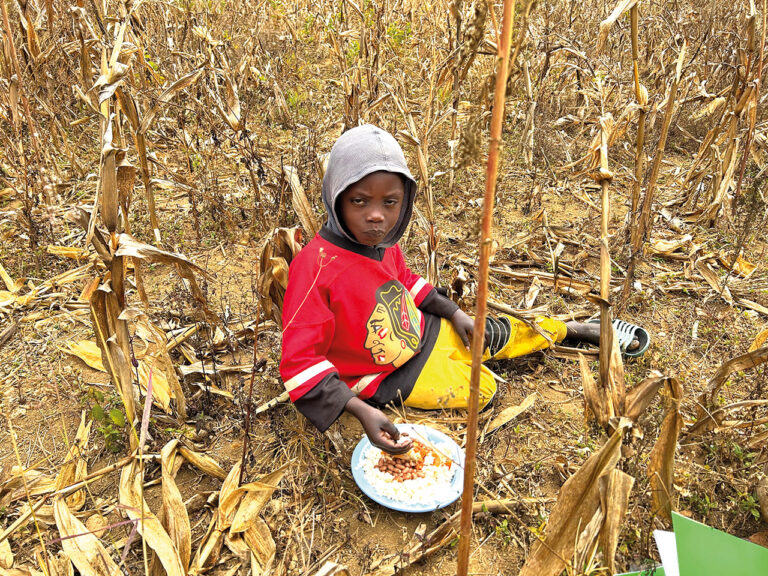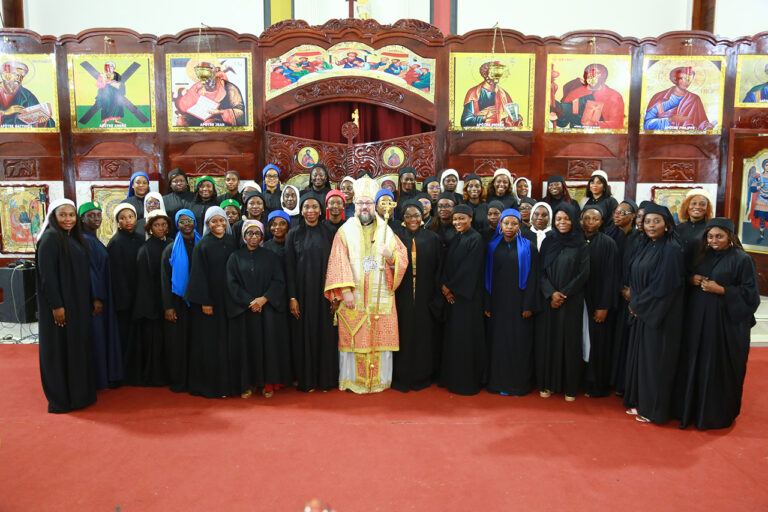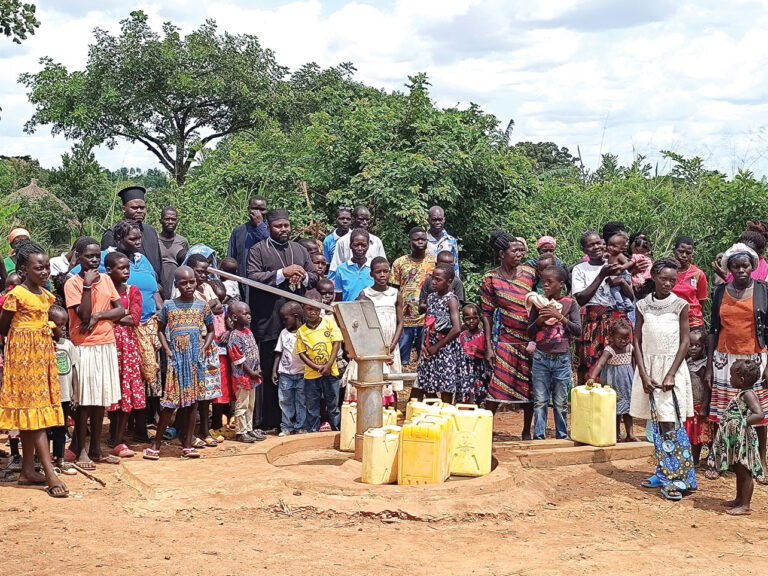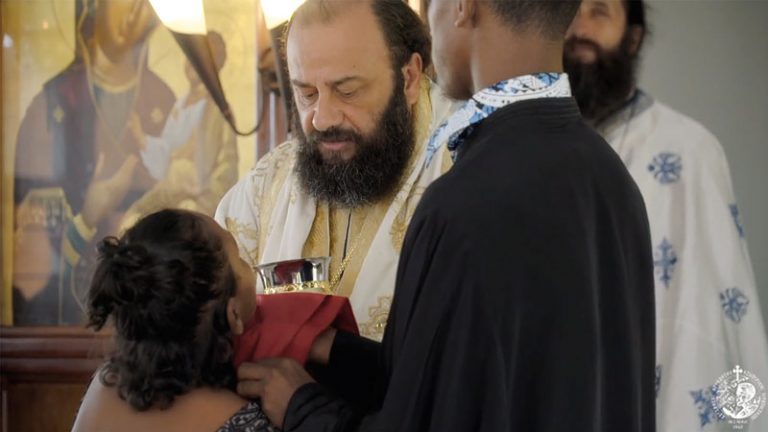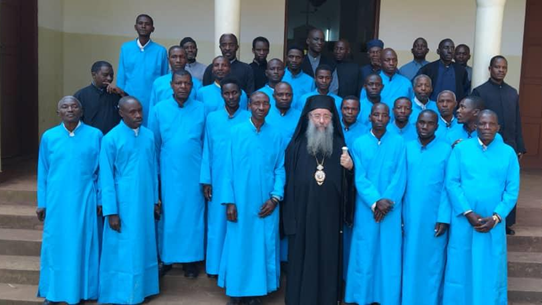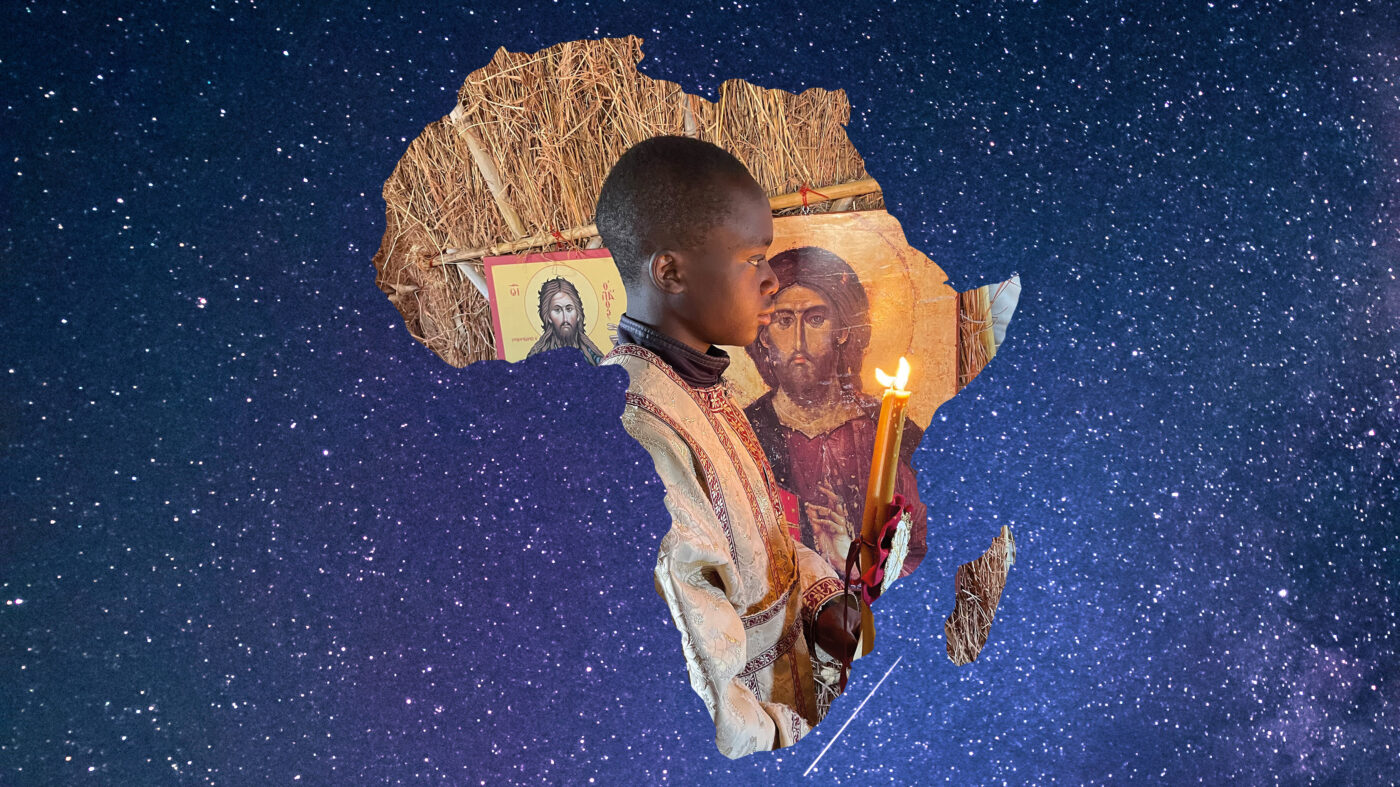Where did the Elder find his Strength?
Fr. Chrysostomos Papasarantopoulos (1903-1972) is the outstanding figure, the spiritual cornerstone of Greek Orthodox missionary work in Africa.
The blessed Father was born in 1903 in Vasilitsi, Messinia, to a family of struggling livestock farmers. At the age of ten, after his father’s death, he was forced to leave school and work to support his family. However, his thirst for learning remained indelible because of his great love for education, though due to his father’s death, he could not continue school and dropped out in the fourth grade of elementary school. Nevertheless, his inner desire for cultivation led him, at the age of 15, to secretly depart and temporarily live at the Holy Monastery of Koroni, which he would temporarily leave due to his family’s persistent demands.
Later, he moved to Kalamata and joined the Holy Monastery of Evangelistria-Skete Panagoulaki, under the guidance of the strict Abbot Elias Panagoulakis, who would introduce him to rigorous ascetic practice. The Venerable new ascetic Elias slept only three hours a day sitting upright, ate very little, used olive oil only on Saturdays and Sundays, and completely abstained from meat and fish.
The harsh ascetic practice would physically affect and exhaust him, but it would strengthen his spiritual constitution. After completing his military service, in 1926 he was ordained a priest and became Abbot at the Monastery of Gardiki in Messinia. Simultaneously, he would perform his liturgical work as a parish priest in various parishes of Messinia.
His unwavering and intense desire for education drove him to complete elementary and high school as a home-schooled student. He enrolled in the Theological School of Athens and, at the age of 55, completed his studies. During his student period, he would come into contact with African fellow students, which activated and shaped his desire and zeal for missionary work in Africa.
In 1958, after guidance and blessing from Elder Amphilochios Makris, who prioritized the discipleship of all nations with the holy island of Patmos as a living and vibrant nursery in his enormous spiritual work, he decided to undertake the supernatural, spiritual journey of missionary work, becoming a living confession of Christ, as St. Amphilochios calls missionaries. Thus, in June 1960, he arrived in Kampala, Uganda, to face difficulties, adversities, and disappointments, such as lack of resources, language barriers, different mentalities, and perceptions. Despite the difficulties, he would inaugurate the first missionary church and work tirelessly for the spread of Orthodoxy.
His activity would soon extend to Kenya, Tanzania, and Congo, where he established churches, educational institutions, and raised native priests. His dedication led to the creation of a dynamic Orthodox community in the region. In 1968, according to testimonies of Elder Paul Nikitaras, the first spiritual child of St. Amphilochios, we find the newly enlisted Saint and Missionary Gabrielia co-serving in this wonderful missionary nursery. In the morning hours as secretary and English translator for Father Chrysostomos, and in the afternoons in nursing institutions and prisons. Elder Paul told me that she slept less than three hours a day.
Elder Paul Nikitaras, when on a mission to strengthen the core of the missionary work and following a spiritual order from his Holy Elder Amphilochios, would arrive in Africa to assist the work of the great Missionary father Chrysostomos. Then he would note characteristically:
“Oh! What was the joy of the ever-memorable father Chrysostomos when he received us at the Church of the Holy Unmercenaries, it cannot be described. He sang by himself: ‘Glory to You who have shown the light, glory to God in the highest…’ His expressions will remain indelibly imprinted in our minds.
And the tireless Missionary of the black people had reason, because he saw his weak flesh protesting against the unbearable burden he had undertaken, and now the hopes for the future of his work were beginning to take flesh and bone. We were in Africa during winter. We did not see for three months the blue sky of Greece, nor the stars at night, nor the sun during the day, and our chest was weighed down by the black fog of the country. Truly, how did he live so many years alone? Has anyone appreciated his offering for the love of our Christ? Only one who will live in Africa can comprehend the magnitude of the sacrifice of a weak flesh such as that of father Chrysostomos. The neuralgia of his stomach tormented him, his salivation became burdensome often, and yet he did not bend. We would lay out the plans in the evening and the next day we would carry out our expeditions. He did not want to miss any expedition. Fr. Chrysostomos fell asleep on December 29, 1972, in the city of Kananga in Congo, leaving behind a rich missionary legacy. His life is an example of dedication, self-sacrifice, and faith in the God-pleasing work of mission.
Once we departed for western Kenya of Akuro, Adonai, Kisumu, with the Land Rover of the Center. With us, we had the elderly father Obadiah, one of the pioneer native Orthodox who found the true faith of the Apostles and the Great Fathers of the Church… In the tropical climate, rains are not something unusual. We had traveled about 300 kilometers and torrential rain begins. Our vehicle was impossible to proceed. The ever-memorable maintained his composure and with youthful vigor sang the verses of Veritis “neither the storm nor the hail frightens us…” and when shortly thereafter our wheels sank in the mud and we were completely immobilized, while crossing a stream, the elder appeared stronger than the young. We lifted the car in our hands, cleared it, and continued our way. And we said where did the elder find his strength!”
Where Did the Elder Find His Strength?
The missionary presence of Fr. Chrysostomos Papasarantopoulos in East Africa constitutes a living testimony of sacrificial, cruciform offering and spiritual anxiety and struggle for the spread of Orthodoxy in places that are inaccessible, forgotten, and, above all, thirsty for truth. The humble Levite, the tireless servant of the neighbor, after eight years of unceasing multifaceted service in Kenya, would emerge as a leading figure of Orthodox Mission having accomplished work—a living and revelatory presence of Grace. Work extending to the spiritual, material, and social renewal of communities. In 1963, to support his work, the Association of Friends of Uganda was founded, which today has been renamed the Orthodox Missionary Fraternity. The two major structural supports in his important missionary work were the Church of Greece and the then Association of Friends of Uganda.
His action was not limited to ritual duties but embraced every aspect of the spiritual and social life of the natives. With zeal and patience, he visited remote villages, conducted Divine Liturgies, baptized dozens of new faithful, inaugurated and founded churches and school buildings. He concelebrated with local and Greek priests, spoke to the faithful, listened to their concerns, and spread the message of Orthodoxy not only with words but primarily with deeds. Faith as a practical ascetic act defines his missionary journey and highlights the greatness of the Orthodox experience.
In his common path with collaborators, Elder Paul Nikitaras of Patmos would stand out, who would heartily actively participate in the mission of 1968, and would contribute in various ways to the Work. The Elder would accompany Fr. Chrysostomos on tours to newly built churches in Kenya and other areas. He concelebrates, co-organizes the educational programs and the catechism of the young natives, as a living dynamic and militant presence by the side of the catechumens. At the same time, Elder Paul would actively contribute to the hospitality, support, and daily organization of the missionary Center, to the creation of educational structures, and to the erection of schools and churches, responding to the social and spiritual need of the communities.
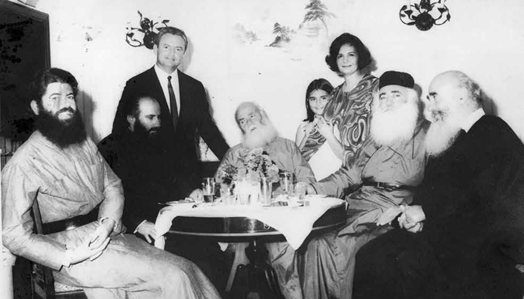
Where Did the Elder Find His Strength?
The answer lies in the continuing self-sacrifice and dedication that inspired him and his collaborators. Fr. Chrysostomos never complained about the difficulties and sacrifices, even when he suffered from serious physical problems, such as neuralgia of the stomach and salivation, which constantly tormented him. Despite all this, he never bent, as the love for Christ’s work and the need to offer spiritual resurrection to his brothers in Africa, outweighed his physical difficulties. Sacrifice for him was the culmination of Orthodox faith and true Christian love, the basis for spiritual growth.
In reality, Fr. Chrysostomos did not “give” simply his time and health for the spread of the Gospel, but he made a deep spiritual sacrifice, where his very life was the sanctified instrument of God. There was no avoidance of his work.
In his speech, there appears a deep concern for the lack of personnel and the absence of administrative and spiritual support. Despite his love and dedication, he felt the need for rest and replacement, as, as it is characteristically mentioned, “what can a person offer, especially an old man without helpers and staff?” As recorded in the missionary texts, Fr. Chrysostomos’s team faced various difficulties in the organizational aspect of the mission, which included the lack of liquidity and funding, and the inadequacy and absence of basic infrastructure, as well as difficulties in systematic cooperation with the local priests. Fr. Paul actively participated in the management and enhancement of the Center’s initiatives, supporting the smooth operation and the realization of Fr. Chrysostomos’s vision.
The urgent need to strengthen missionary efforts and cooperation with the Church of Greece and the Patriarchate of Alexandria emerge as critical points for the success of the work. Fr. Chrysostomos’s proposals for institutional solutions, such as the training of priests, language enhancement, and the strategic presence of educators, make sense only with active support from the entire Church.
The absence of structure and the inability to manage the increased needs of the local Church, the poor organization of catechism, but also the problematic cooperation with the native priests, created obstacles that he himself tried with wisdom and discernment to solve. His speech, in many points, heralds the need for systematic support and organization in missionary action, so that the work does not remain only in individual struggle, but becomes ecclesiasticized and transformed into a plan of true cooperation.
Recognizing that Orthodoxy cannot numerically compete with other Christian confessions or religions that dominate in Africa, Fr. Chrysostomos focuses on the essence of the mission. For him, it is not enough to build churches; it requires the building of “ensouled temples,” that is, people kneaded with the spirit of the Orthodox experience. Only in this way can the Orthodox Church have a future and roots in African soil. Orthodoxy is alive and active and as such requires the building of living temples – souls that are ready to witness Christ’s love in the world. This call for spiritual rebirth is the key to the success of Fr. Chrysostomos’s work, but also for the essential transformation of the communities in which he worked.
His speech is not devoid of self-criticism. With frankness, he asks for the organized enhancement of the Mission from the Greek Church and cooperation with the Patriarchate of Alexandria, proposing institutional solutions, such as the introduction of the English language in Ecclesiastical Schools and the secondment of educators to Africa. He foresees that the work of Orthodoxy requires strategy, human resources, and, above all, faith and vision. This recognition of the need for strategic cooperation and the education of local priests and communities is the foundation for lasting spiritual development, not only for Orthodoxy in Africa but also for the global spread of the faith.
Through the text, Fr. Chrysostomos appears as a rare figure: a humble worker of the Gospel, with deep theological thought, practical mind, and inexhaustible love for humanity. His presence in Africa was not merely symbolic; it was decisive. He was not only a liturgist but also a shepherd, teacher, social worker, builder, and brother. This theological integrity and the union of the practice of faith with love, the practical manifestation of faith as love, makes Fr. Chrysostomos an example for the ecclesiastical journey and the struggle for humanity.
Through this narrative, it becomes clear that Fr. Chrysostomos’s legacy is not exhausted in what he himself accomplished, but opens the way for those who are called to continue. His voice remains relevant: “philanthropic institutions, nursing homes are needed.” Orthodoxy in Africa needs persons and not just presences. It needs testimony and not just structures. And Fr. Chrysostomos was precisely that: a living testimony of faith, hope, and selfless offering. Orthodoxy, finally, is not an ideology, it is a continuous theological act, a loving stance, dedication to God and fellow human beings. Elder Paul Nikitaras conveys the climate to His Eminence, the Archbishop of Athens and All Greece Ieronymos, on 09/26/1968:
“The Orthodox of East Africa do not unfortunately exceed 40,000 while the Catholics, Anglicans, Lutherans, Protestants, exceed fifty million, and the Muslims, Hindus, amount to more millions; this means that the light of Orthodoxy dimly illuminates the darkness of vast Africa. Hence arises the question why Orthodoxy does not gain ground and lags far behind other Christian confessions and other religions?”
The answer is very simple, because Orthodoxy did not have nor does it have capable missionaries, only about twenty years ago is there talk about it, while the Catholics and others have a century of action. And because we lack organization in the Missionary centers of the Orthodox.
As pioneers of the Orthodox movement, are considered the Native Priests in Uganda Fr. R. Spartas and Fr. Obadiah, and in Kenya Fr. Arthur Gaduna, and they mention with respect the first Greek Missionary Archimandrite Nikodimos Sarikas, parish priest of the Holy Church of the Annunciation in Arusha, Tanzania. Although the Patriarchate of Alexandria recognized the priesthood of the above first Orthodox native Priests, nevertheless there are dark points whether they are canonically ordained or not. I can certify from personal experience, that the ground for Orthodoxy is very favorable everywhere during our tours the Africans proclaimed their desire to become Orthodox, because from Orthodoxy originated the other dogmas and they want to know the Source, the first Christian religion, Orthodoxy, the CARIGA, as they themselves say, and the presence of Orthodoxy is imposed also from the current psychology of the Africans. Consequently, indifference to the call of the Africans can be characterized as indifference and little faith in the luminous radiation of our Orthodox Faith.
The missionary center of Africa, headed by the missionary Fr. Chrysostomos who has been there for eight years, experienced a day of true Christian edification, the presence of Orthodoxy became felt. Divine liturgies, consecrations of holy churches, foundations of school buildings, foundations of holy churches, events of ecclesiastical Sunday schools, contacts with the villagers of Africa, and group baptisms of our new Orthodox brothers were the occupations of the Greek Orthodox Christian center of East Africa during the months of July and August.
And all these are due to the initiative of the Holy Archdiocese of Athens. Shortly, our educational clerics return to their duties and Fr. Chrysostomos will again be abandoned alone in this vast Country, why shouldn’t similar missions of our clerics to Africa from our missionary office in Athens continue?
I will present to you indicatively some chronological stations of his activity, which will be heard for the first time here, recorded by the blessed Elder Paul Nikitaras.
July 18, 1968
Arrival in Nairobi.
Participation in the funeral of M. Louros.
Installation at the Missionary Center.
July 20, 1968
Divine Liturgy of Prophet Elijah – exit to village first, contact with villagers with eagerness and joy father Eleftherios priest of Saint Panteleimon receives us. We saw many working in the churchyard voluntarily. Saturday Vespers-discussion of missionary action, local cooperation, individual image of the situation. Creation of first priests, then Churches-need for a center of monasticism for missionary service.
July 22, 1968
Visit to the village of Kesa for leveling the plot for the erection of a Holy Church.
July 23, 1968
Divine Liturgy-visit with Fr. Chrysostomos to the village of Kangira where a new church of the Saint is being built-contact with the students of the school-distribution of crosses-in the evening we dined with ambassador Papadopoulos with a projection of holy places-we exchanged views.
July 28, 1968
Consecration at Saint Panteleimon, 14 priests and deacons concelebrating, of whom I, father Chrysostomos, and father Amph. Inside the Holy church came the lieutenant governor, the Mayor, the ambassador, and other officials- Evening Vespers and narration of father Obadiah.
August 09, 1968
We departed after Matins and related preparations to Western Kenya. Through the city of Nakuru-Kisumu we arrived in the region of Kananga amid torrential rains of tropical countries we arrived at the village of Changi of the Maragozi tribe-fortunately the main road was asphalt, but on the dirt roads our journey was difficult, the car in the muddy terrain slid, struggled, and our pounding hearts were not missing lest we get stranded on the road-but God is with us, we discover while tracing the Church of St. Matthew. The parish priest papa-Matthew hospitable good-hearted received us in his hut, poor and primitive, but rich in expressions of love and kindness- our entourage consisting of Fr. Chrysostomos, Fr. Obadiah, George Patronos, our driver Peter, an Orthodox resident of Nairobi and myself settled in the hut of the good pauper, he introduced to us his wife and children, eleven in number and led us to our dormitories after the discussion we had around our mattress-the service of vespers without books we sang in the Church, the compline in our bedrooms-sleep was sweet, the fatigue of our journey made sleep continuous.
August 11, 1968
In the morning, I with professor Patronos went for liturgy to Saint Paul 3 kilometers from the center-Fr. Chrysostomos with father Obadiah went for liturgy to Changi to Saint Matthew-complete disorder on the part of the priests-I only had my vestments, the parish priest had forgotten his antimension and immediately left to find it, he has 5 other parishes far from St. Paul 30 kilometers- 8-11 a.m. sermon by prof. Patronos and myself. Liturgy was not performed, but baptisms of 11 persons of whom 2, Helen 30 years old and Suzana 17 years old, the baptism inside a basin the baptized children were named Joel, Salome, Sophia, Fevronia, Josephine, Daniel, Nathaniel, and Daniel the godparent was G. Patronos. The basics were missing-not even a godparent cloth-complete lack-subsequently, the rain which came down torrentially forced us to leave on foot towards our center.
August 13, 1968
We went to Kanenga, visited the authorities for the purchase of a plot and continued to the churches of the same region to St. Anchileion of the village of Chibiyeva with parish priest Fr. Nikephoros, here there is a youth movement, it is worth to be strengthened-The Church needs an iconostasis, icons, oil lamps, seats, we read prayers for the construction of a Holy Church. Events with dances, songs-church in Chibiyeva with half-finished zinc and were hosted in the house of the youth leader-Church Maniyenga with zinc has deficiencies-in Brihili we laid the foundation for a Church with a wooden pillar instead of stone-And in Ebuyanga we saw a private Church, we met the founder, a poor worker.
August 15, 1968
Concelebration at the Holy Church of St. Andrew.
Hospitality and contacts with local priests.
August 17, 1968
After Matins and breakfast, we visited in the hospital the ambassador who had suffered a car accident and in the afternoon a visit to the priest Fr. Joachim who had suffered an accident and the house of Gadounas and Fr. Amphilochios where a blessing was done for the ailing presbytera and later we went to St. Paul.
August 18, 1968
Divine Liturgy at Kagiza with participation in a festival of the Orthodox Youth of Kenya.
August 19, 1968
Model Liturgy for the guidance of local priests.
August 23, 1968
I celebrated liturgy at St. George of Zaga and subsequently with Mrs. Kogchelaki we visited the cemetery where the tomb of the first missionary Archimandrite Nikodimos Sarikas (1870-1941) is, we performed a memorial service. We saw the Indian Ocean, had lunch, and departed again via Muheza Mosehi to Arusha where we arrived at night.
August 25, 1968
We went to a village where Fr. Peter serves as parish priest. At a school, we performed Divine Liturgy with the parish priest and Fr. Amphilochios. After the Liturgy, in a nearby small lake with the help of Fr. Justin Polyzas, baptisms took place, the baptized – small and large – received Holy Communion, they were from the ‘Kikuyu’ tribe and a few from the Masai tribe – crosses were given – a meal followed and then return to Arusha from where G. Patronos and Fr. Justin departed for Nairobi to leave the next day for Athens. I with my sister remained only in Arusha.
August 29, 1968
Meeting with local priests on issues of the Ecclesiastical School.
September 8, 1968
Divine Liturgy at Saints Constantine and Helen — Speech by Fr. Chrysostomos.
September 10, 1968
Divine Liturgy at the Komninos house.
Visit to an area for the erection of a new church of Christ the Savior.
Epilogue
The Elder Missionary
Note: The Elder is a living witness of Grace for the Orthodox experience.
Now that he sleeps the sleep of the righteous souls and rests in the country he so loved, all of us must think of our responsibilities to the Lord. Will we forever turn a deaf ear to the call of the missionary of Africa and to the command of our leader “go, make disciples of all nations…?” He did not spare his life and was deprived of everything for the love of the Savior, so we should imitate him. From his grave, he calls to us: “Be imitators of me, as I am of Christ” and furthermore for the good of our Orthodox Church to honor the brave athlete. He showed such self-denial as no other priest in Greece. Our black brothers called him “muzé” that is, Elder, and loved him as he loved them, surely now he holds a brilliant position among God’s elect and should be proclaimed a Saint by our Church. He deserves it. It is our duty and we must do it.
Bibliographic Sources
Archim. Paul Nikitaras, St. Amphilochios of Patmos, seventh edition, Holy Patmos 2019.
Archim. Chrysostomos Papasarantopoulos (1903-1972), edition of the Hellenic Society of Orthodox External Mission (the Orthodox Missionary Fraternity), Thessaloniki 1974.
Unpublished text of Archim. Paul Nikitaras, Patmos-Africa, n.d.
Letter of Archim. Paul Nikitaras to His Eminence, the Archbishop of Athens and All Greece Ieronymos, 09/26/1968
Ignatius Triantis Metropolitan of Veratios, St. Amphilochios, the Elder of Patmos (1889-1970), ed. Holy Monastery of Evangelismos



